East SIG Report February 2021
Neil Muller
Host Frank Maher opened the first East SIG’s meeting for 2021 again hosted via Zoom. After welcoming members, the meeting then commenced with George Skarbek presenting Q&A.
- The first question of the night related to connecting to the meeting via Zoom.
On my notebook, why is the F7 key with “mute” written on it, not toggling sound on?
A My F7 key increases the brightness of the screen. You’ll find the function keys F1 to F12 vary from manufacturer to manufacture and sometimes between models. Otherwise, I can’t help with your F7 mute key.
- I’m preparing a PowerPoint presentation for the first time. In the presentation, I want to include a hyperlink to a YouTube video. Can you put hyperlinks into PowerPoint?
From the Insert tab I used the link icon, put a name in, and copied and pasted the hyperlink from the YouTube URL. The link then appeared on the PowerPoint page. When I click on the link it doesn’t work. I also tried to run the hyperlink while in presentation mode and that didn’t work either.
A You definitely can use hyperlinks in a PowerPoint presentation. Copying and pasting the URL from the YouTube video is also correct, so you appear to have done all the right things.
[Dave Botherway] I’ve used hyperlinks in PowerPoint presentations numerous times without any problems. What I do to insert a hyperlink is to move to the page where I want the hyperlink. From the Insert tab, I select the Link icon on the ribbon bar. In the dialogue box that opens, I enter a description for the hyperlink and paste the URL of the YouTube video in the address box. This seems to work okay but you need to be running the presentation for the hyperlink to work.
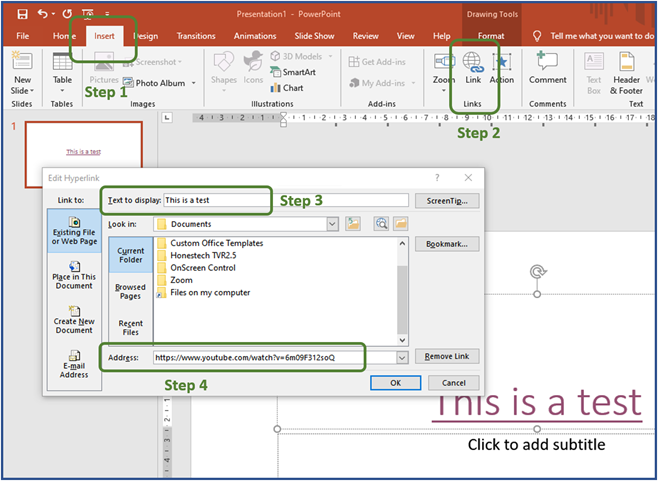
Figure 1 – Inserting hyperlinks in PowerPoint.
[George] A tip that may help when testing a PowerPoint presentation is the F5 function key will start the presentation at the beginning, but Shift + F5 will start the presentation from the current slide that you need to verify is working.
[Dave Botherway] Another thing I do is to download the video to my PC. I then run the video from my PC when presenting it. That way I’m not dependent on downloading the video to my PC while broadcasting it out again via Zoom. The more I can broadcast from the desktop the better. You’ll therefore need to find some software that will allow you to download the video from YouTube. “Download Helper” and “4K Video Downloader” were 2 programs mentioned by audience members that they found work for them.
The future format of EAST SIG Meetings for the remainder of 2021 was the next item discussed. The session was run by Dave Botherway, who is one of six members who form the East SIG committee. The committee is keen to restart face-to-face meetings as they see a lot of value in the informal social interaction that occurs at those meetings. Members were advised they would be presented with meeting options and conditions, following which a poll will be taken to determine their preference.
Due to the COVID-19 pandemic, Whitehorse City Council has added extra requirements on our members attending face-to-face meetings at Eley Park. Dave outlined the council’s requirements which are currently set to run for the remainder of 2021. These requirements would necessitate extra work and conditions placed on those members attending face-to-face meetings.
The alternative to face-to-face meetings was to hold meetings via Zoom. Dave indicated it was too early to determine whether hybrid meetings would be practical, due mainly to audio quality issues, so this option was not included. He also noted that if Zoom meetings were to replace face-to-face meetings, there is a risk that East SIG would lose the booking for the Eley Park hall. If the preference of members was for Zoom meetings, the committee is considering allowing extra time for ad-hoc social interaction. “Breakout rooms” are a possible option to create smaller groups of 5 or 6 people. Dave plans to include a presentation on Zoom “Breakout rooms” next month.
A Zoom poll comprising 2 options was then run to gauge members meeting preferences. The outcome was approximately two-thirds favoured Zoom and one-third face-to-face meetings. Comments by some of those supporting Zoom were that they would not be able to attend otherwise due to distance, having to travel at night in winter, and some for COVID-19 health concerns.
Following on from Dave, Trevor Hudson presented a video he’d prepared titled “How to enable Audio Description on TV”. Trevor researched this topic to assist his elderly father who is visually impaired. Audio description is available on some SBS, ABC, and Netflix programs and works with most common brands of smart TV’s.
Audio Description is the narration of visual and non-verbal parts of a program, vocalised in gaps of the program’s audio or dialogue. Its purpose is to inform visually impaired people, so they have a greater understanding of what is presented on the TV screen. Along with subtitles, audio descriptions can be turned on and off. Trevor’s video displayed the menus needed and steps involved to setup audio descriptions on a smart TV. To show audio description in action, Trevor then played two different TV scenes, the first with audio description turned off and then turned on. Trevor mentioned that on occasions he’s left audio description turned on when watching a program and found it picked up details he’s missed.
Trevor’s video along with “How to enable Audio Description on Netflix” is available on YouTube by searching the video’s title or Trevor’s pseudonym HX7V.
After a short break Neil Muller gave a presentation on “Simple TAB Groups” and posed the question is this a better bookmark manager? Simple Tab Groups is a Firefox add-on that creates and modifies tab groups. It’s a very easy way to declutter your browser tab bar and organise your tabs to make webpages easier to find. It does much more than just combining tabs into groups which Neil demonstrated during the presentation.
When browsing the internet, Neil found it more convenient to leave tabs open, rather than creating bookmarks and closing the tabs. After a while, tabs had accumulated and the websites he needed to refer back to were becoming harder and harder to find. After searching the internet for a solution, Neil discovered Simple Tab Groups and gave it a try. It’s now become one of Neil’s must-have apps on his computer.
After a brief introduction to Simple Tab Groups, Neil demonstrated how to install the add-on using screen captures to show the process involved. Installation commenced by selecting the 3 horizontal bar icon at the top right of the Firefox toolbar. A drop-down menu appears and “Add-ons” is selected. A Window opens that displays the Firefox extensions page, where the name Simple Tab Groups is entered in the “Find more add-ons” box. Clicking the magnifier glass takes you to Firefox’s Add-ons page, where Simple Tab Groups is shown and selected. The developer’s (Drive4ik) webpage now appears where you click the “+ Add to Firefox” button. Two further windows appear where you give your permission to add Simple Tab Groups to Firefox and to acknowledge that Simple Tab Groups has been installed. The default icon for Simple Tab Groups is a 3 x 3 dot matrix.
Neil then played the video by Percy Jules that convinced him to give Simple Tab Groups a try. The video is now over 2 years old but still gives a very good introduction to the add-on for anyone wanting to give it a try. As you would expect new features have been added and there are some minor differences from those shown in the video. These updates have improved Simple Tab Groups even further. The video is called Simple Tab Groups My new favorite Firefox addon…?“ by Percy Jules at https://www.youtube.com/watch?v=6m09F312soQ
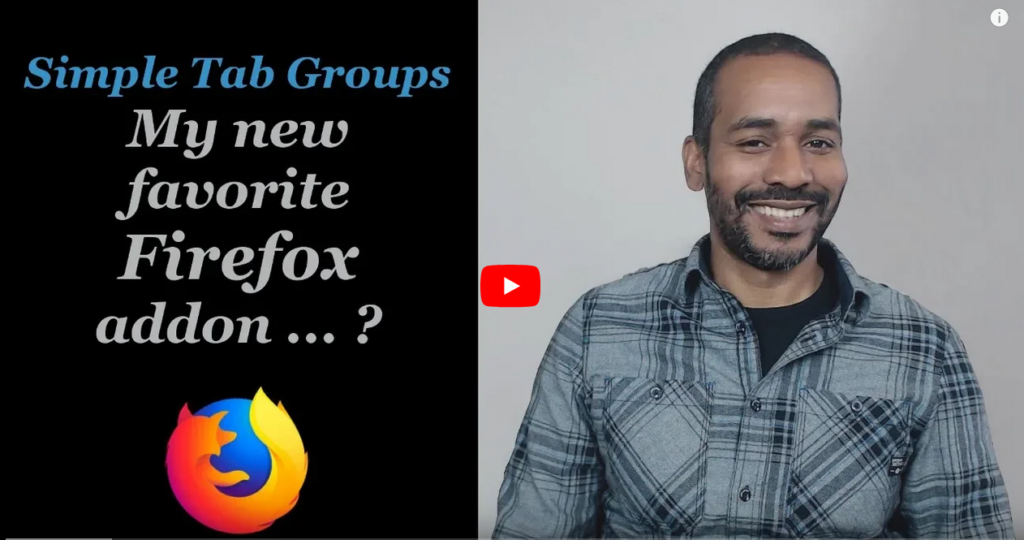
Figure 2 – Percy Jules video Simple Tab Groups
The Percy Jules video assumes an installation of Simple Tab Groups with no previous tabs open. However, many users like Neil will already have many tabs open. Neil then demonstrated how those users with tabs already open would run Simple Tab Groups for the first time. The initial step is to list all the tab group headings you think you’ll need. Next, select the Simple Tab Groups toolbar icon and click “Create new group” (refer Figure 3). This will create your first group which will contain all the tabs on the tab bar. From here you create new tab groups using the topic headings you listed earlier. From the toolbar icon select “Manage Groups” and from the window that opens, tabs are dragged from the first group into their appropriate named groups.
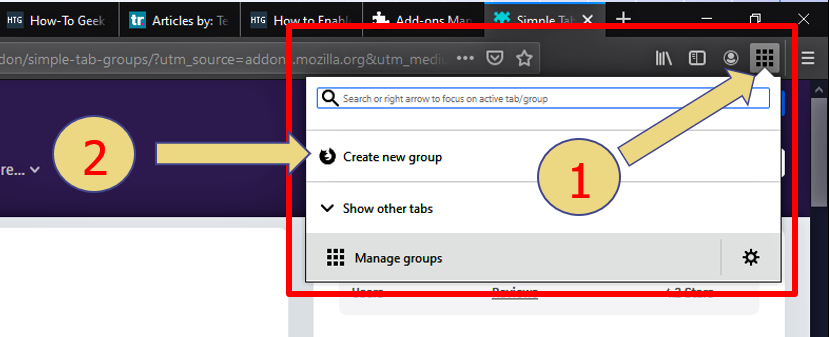
Figure 3 – Simple Tab Groups Toolbar menu prior to creating the first group
An alternate method of moving tabs into groups is to right-click on a tab and select “Move tab to group”. This adds the tab to one of the newly created groups and removes it from the initial (current) group and it disappears from view. Neil found this method more time-consuming for the initial sort (more clicks), but the best option later when you find a tab in the wrong group and wish to move it to another group. (refer to Figure 4)
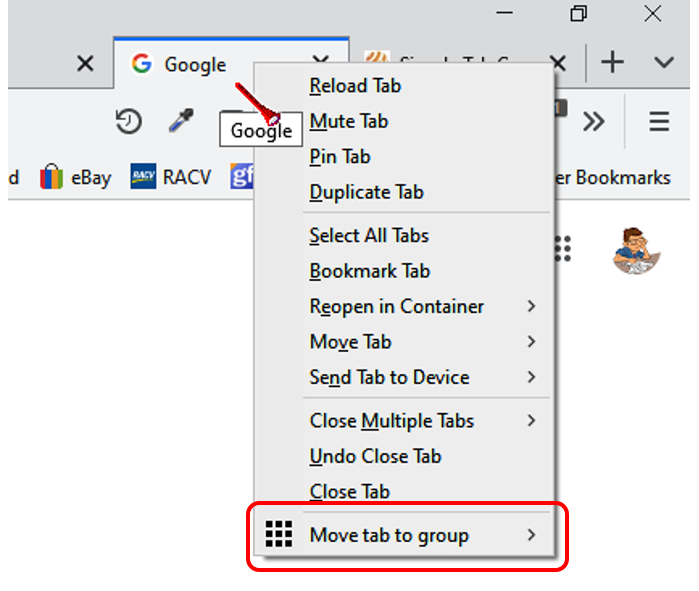
Figure 4 – Simple Tab Groups Right-click menu
After demonstrating how to initially move tabs into their correct Tab Groups, Neil looked at some of the most useful features of Simple Tab Groups and how to access them.
From the Firefox toolbar, select the Simple Tab Groups icon to open the toolbar menu. (refer to Figure 5). This menu offers 3 options, the first is to select which Tab Groups to display on the Firefox tab bar. Selecting one of the many Tab Groups will then display all tabs in that group and hide all other groups from view. A feature of Simple Tab Groups is tabs are active (open) or inactive (closed). Therefore, when you load a tab group, only those tabs accessed in the current session will be active. All other tabs in that group will remain inactive until you click on the tab to open it.
The remaining 2 options in the Toolbar menu allow you to “Create a new group” or “Manage groups”.
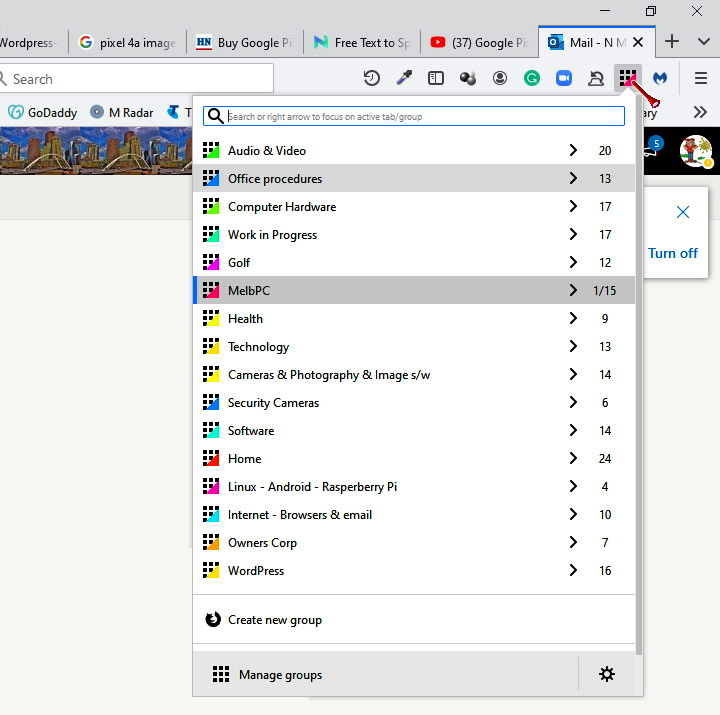
Figure 5 – Simple Tab Groups Toolbar Menu
Toolbar Menu – Tab Groups Options & Features:
Selecting the Simple Tab Groups icon on the Firefox toolbar opens the toolbar menu. The first item in the menu displays all the Tab Groups you’ve created. There is a wealth of information available from this section of the menu, the most important I’ve listed below including 2 screenshots used by Neil in his presentation.
- One method to determine which Tab Group is currently displayed on the Firefox tab bar is from the toolbar menu. In Figure 5 you can see Neil’s “MelbPC” tab group is highlighted by a grey band and a vertical blue bar to the left of the group name. This indicates “MelbPC” is the current tab group loaded in Firefox’s tab bar. All other Tab Groups are now hidden from view.
- On the right side of the grey bar, a numeral displays the number of tabs in the group and how many are active. In the above example, 1/15 refers to one active (open) tab out of a total of 15 tabs in the group.
- By hovering the mouse cursor over the numeral mentioned above, another window appears showing a brief description of the contents of each tab. This window disappears when the cursor is removed. The description for active tabs is preceded by a zero and inactive tabs by a star.
If you click on the caret icon beside the numeral, a permanent display of the group contents window is displayed. Here you can scroll through all the tabs in the group and select a tab to open in your browser. Unlike the former window, active tabs appear in heavier text. It also allows the user to close any tabs no longer needed. Both of these features are depicted in Figure 6. - Selecting any of the Tab Groups from the Toolbar menu opens that group and displays it on the Firefox tab bar. The previous Tab Group is replaced by the new Tab Group.
- Right-clicking on any of the Tab Groups in the toolbar menu opens a context menu. (Figure 7) Options available in the context menu include Open group in a new window, Sort groups alphabetically, export the selected group to bookmarks, and to reload all tabs in the group. You can discard the selected group or all other groups, or delete the group completely.
- When audio is playing and the source is unknown, the Toolbar menu helps by displaying a speaker symbol beside the culprit’s Tab Group name.
- During question time Neil was asked whether there was an option to move all bookmarks to Tab Groups. As can be seen in the context menu in Figure 7, it’s possible to “export group to bookmarks”, however, Neil was not aware of the reverse action.
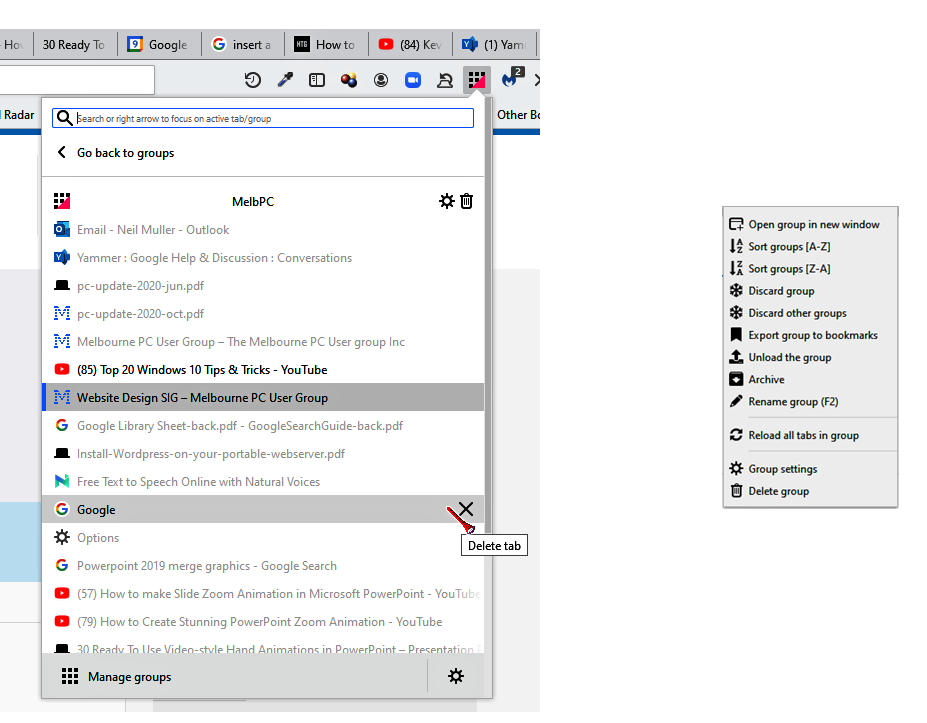
Figure 6 – “MelbPC” Tab Group contents window Figure 7 – Context menu
Toolbar Menu – Create new group:
The second item on the Toolbar menu is to create a new tab group. Here you create a new and empty Tab Group. Refer to Figures 3 and 5. This option is one of a number of ways you can create a new tab group.
Toolbar Menu – Manage groups:
There are 2 options available under this menu item.
- Select “Manage groups” and a new window opens with all Tab Groups displayed in a grid pattern. Each Tab Group in the grid is represented by a window listing all tabs in that group, similar to that shown in Figure 6. Various display options are available and searching for keywords within all groups is a handy feature for finding a “lost” website or article. Neil still uses the Firefox bookmark bar for sites visited regularly but finds the Simple Tab Groups search feature more convenient for finding previously visited web pages.
- The gear icon to the right of “Manage groups” is used to access Simple Tab Groups General settings area. This is one area you will rarely use with the default settings adequate for most needs. There is a backup option available in this area that you may wish to change from the once-a-day backup. Unfortunately, Simple Tab Groups auto backups can only backup to the download folder.
After a live demonstration of Simple Tab Groups, Neil briefly looked at how other browsers are implementing tab groupings. Chromium based browsers, namely Google Chrome, Opera and Microsoft Edge are currently introducing tab grouping into their browsers. As yet Firefox has not implemented this feature into their browser, however, Neil felt Firefox couldn’t improve on Simple Tab Groups.
The tab grouping feature in the Opera browser is called Workspaces and impressed Neil more than the other Chromium based browsers he investigated. Workspaces is accessed via Opera’s sidebar and is simple and easy to use. Much like Simple Tab Groups, when you select a tab group from the sidebar, only those tabs in that group are displayed on the tab bar.
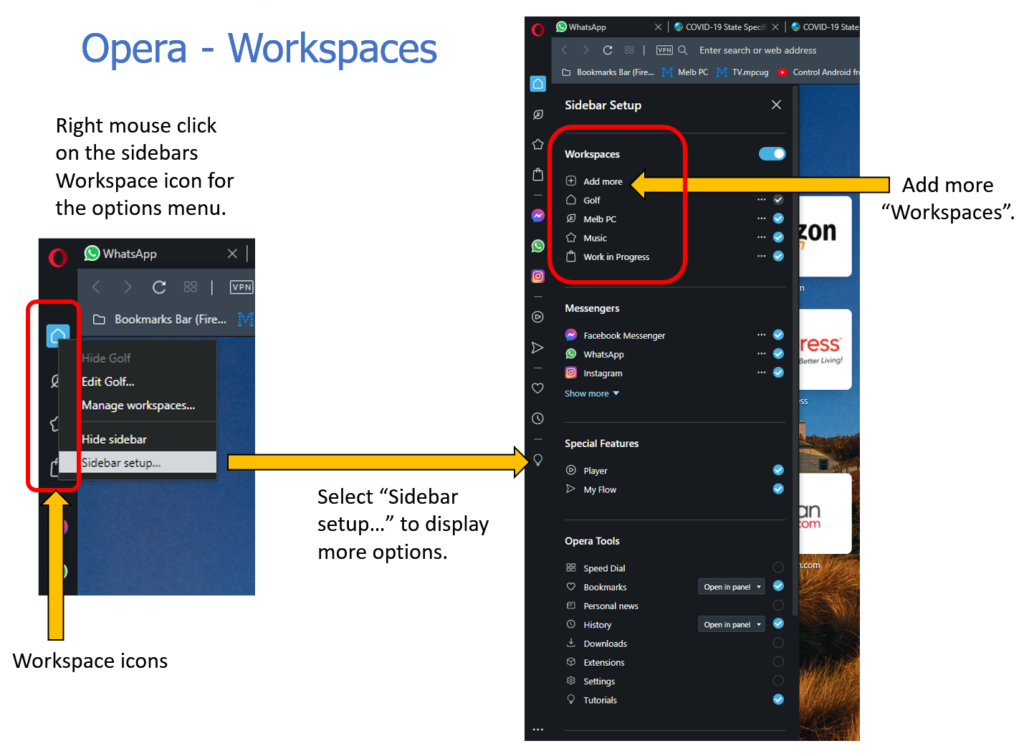
Figure 8 – Opera Workspaces
At the time of writing Google Chrome’s tab group feature, called “Tab Groups Collapse”, warns it’s an experimental feature. “Tab Groups Collapse” allows tab groups to collapse and expand, but unlike Opera, closed tab groups remain on the tab bar (Figure 9). Neil felt this a disadvantage because the closed tab groups take up space on the tab bar, leaving less room for open tabs.
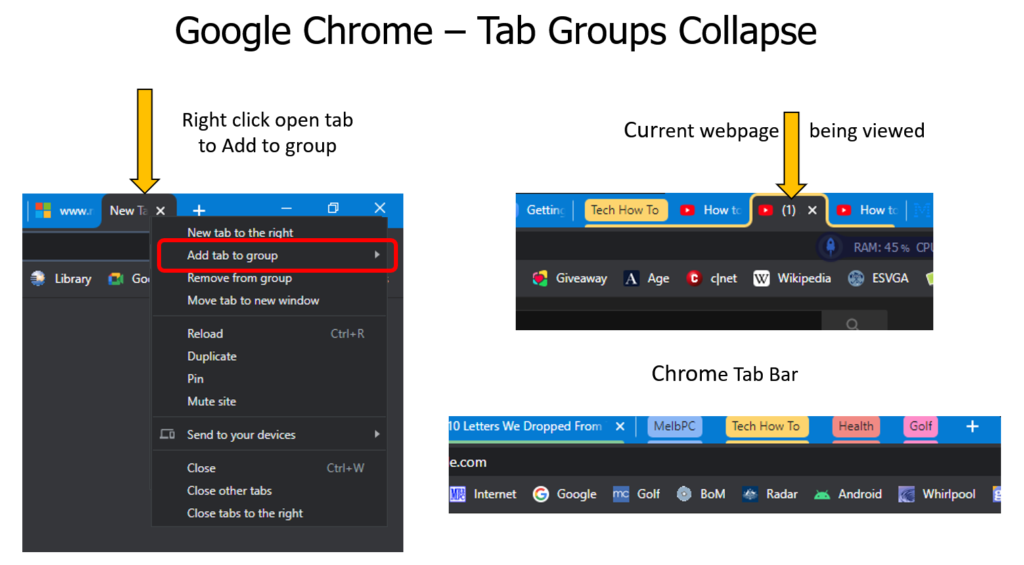
Figure 9 – Google Chrome “Tab Groups Collapse”
Microsoft Edge’s tab group feature is called Collections. Neil spent less time investigating Collections but felt it looked promising but was not likely to change his preference for Simple Tab Groups.
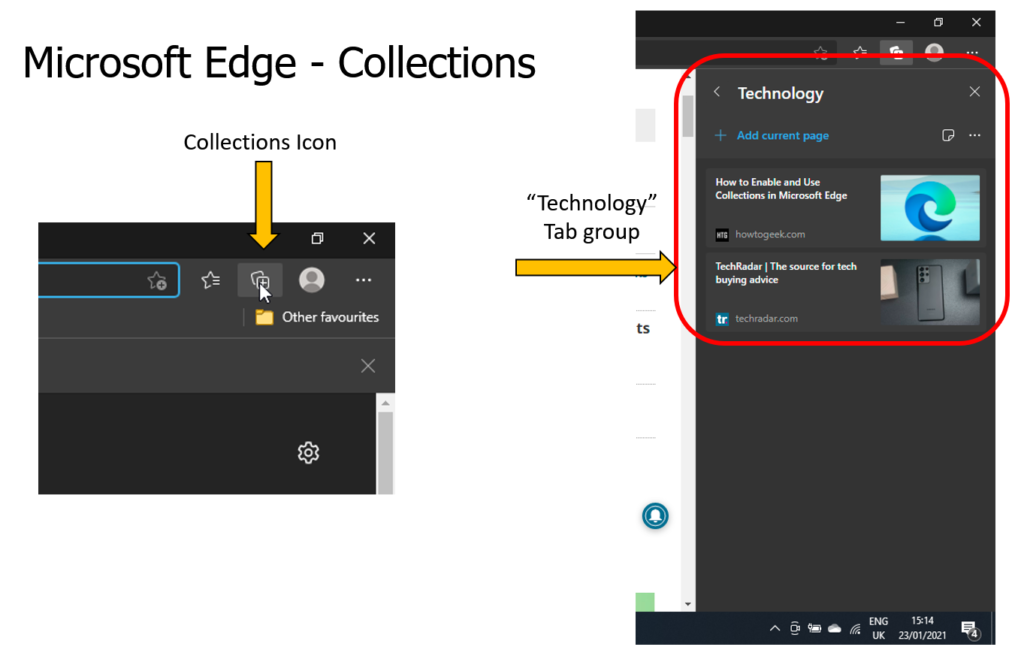
Figure 10 – Microsoft Edge – Collections